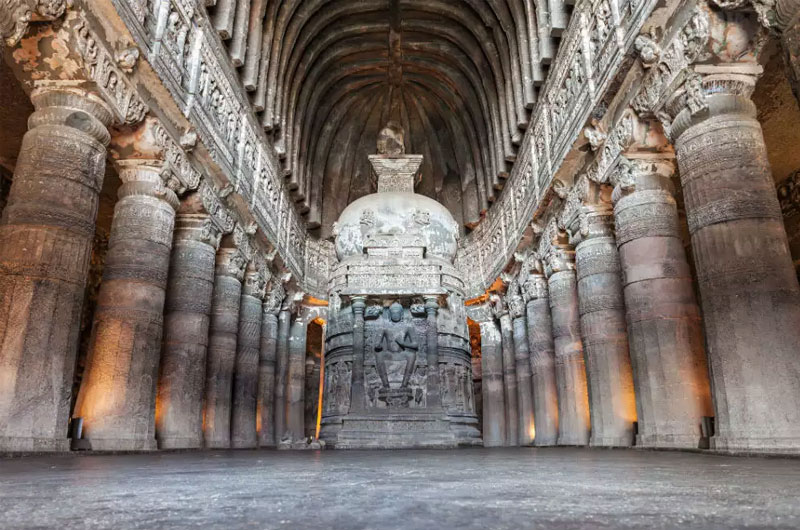
Ajanta Caves: A World Heritage Site
The Ajanta Caves, a UNESCO World Heritage Site, are a magnificent collection of rock-cut caves located in Maharashtra, India. These caves, renowned for their exquisite murals and sculptures, date back to the 2nd century BCE to the 6th century CE. The Ajanta Caves serve as a significant repository of ancient Indian art, architecture, and religious heritage, attracting scholars, historians, and tourists from all over the world.
Historical Background
- Origins and Construction
- The caves were developed in two phases: the first during the Satavahana period (2nd century BCE to 1st century CE) and the second during the Vakataka period (5th to 6th centuries CE).
- Initially used as a monastic retreat for Buddhist monks.
- Buddhist Significance
- The caves are predominantly associated with Theravada and Mahayana Buddhism.
- Serve as a testament to the spread of Buddhism and its artistic expression in ancient India.
Architectural Marvel
- Design and Structure
- Consist of 30 rock-cut caves, carved into the face of a U-shaped cliff overlooking the Waghur River.
- Divided into two main types: Chaitya-grihas (prayer halls) and Viharas (monastic halls).
- Notable Caves
- Cave 1: Known for its stunning mural paintings depicting the Jataka tales and life of the Buddha.
- Cave 2: Features intricate sculptures and paintings, including a famous depiction of the Thousand Buddhas.
- Cave 9: One of the oldest chaitya-grihas, with a large stupa and exquisite carvings.
- Cave 10: Contains some of the earliest murals, illustrating the life of Buddha and other significant figures.
- Cave 19: A chaitya-griha with a beautifully decorated façade and intricate carvings.
- Cave 26: Famous for its reclining Buddha statue and elaborate carvings on the stupa.
- Artistic Excellence
- Frescoes and paintings depicting the Jataka tales, illustrating the previous lives of Buddha.
- Sculptures and carvings reflecting both religious and secular themes.
- Use of natural pigments to create vivid and enduring colors.
Specialty of the Ajanta Caves
- Artistic Brilliance
- Showcase some of the finest examples of ancient Indian art and craftsmanship.
- Renowned for their detailed frescoes, considered masterpieces of Buddhist religious art.
- Historical Significance
- Provide valuable insights into the social, cultural, and religious life of ancient India.
- Represent the zenith of rock-cut architecture and artistic expression during the Gupta and post-Gupta periods.
Tourism Aspects
- Visitor Experience
- Guided tours available in multiple languages.
- Informative plaques and audio guides for self-paced exploration.
- Well-maintained pathways and viewing platforms for a comfortable visit.
- Nearby Attractions
- Ellora Caves: Another UNESCO World Heritage Site, located about 100 kilometers from Ajanta, showcasing Hindu, Buddhist, and Jain rock-cut temples.
- Bibi Ka Maqbara: Often referred to as the “Taj of the Deccan,” located in Aurangabad.
- Daulatabad Fort: A historic fort located near Aurangabad, known for its formidable defenses and stunning views.
- Events and Festivals
- Annual cultural festivals showcasing traditional music, dance, and art forms.
- Special exhibitions and scholarly conferences on ancient Indian art and architecture.
Impact on Locality
- Economic Significance
- Major contributor to the tourism industry in Maharashtra.
- Provides employment opportunities for local guides, vendors, and artisans.
- Cultural Influence
- Enhances community pride and historical awareness.
- Promotes the preservation of traditional crafts and cultural heritage.
Preservation and Challenges
- Conservation Efforts
- Managed by the Archaeological Survey of India (ASI).
- Ongoing restoration and maintenance to preserve the structural integrity and artistic value.
- Environmental Concerns
- Impact of natural weathering and environmental degradation.
- Measures to control visitor impact and ensure sustainable tourism practices.
Conclusion
The Ajanta Caves stand as a monumental testament to the artistic brilliance and religious devotion of ancient India. As a UNESCO World Heritage Site, they not only draw tourists and scholars from around the globe but also underscore the rich cultural heritage of India. The ongoing efforts to preserve and protect these architectural marvels ensure that they continue to inspire awe and admiration for generations to come.
